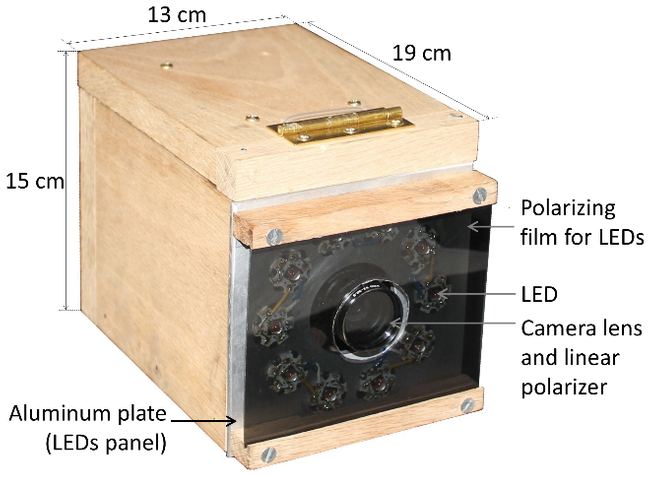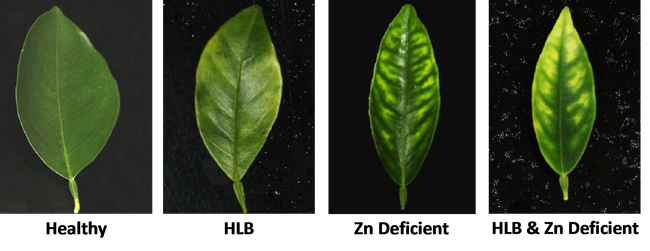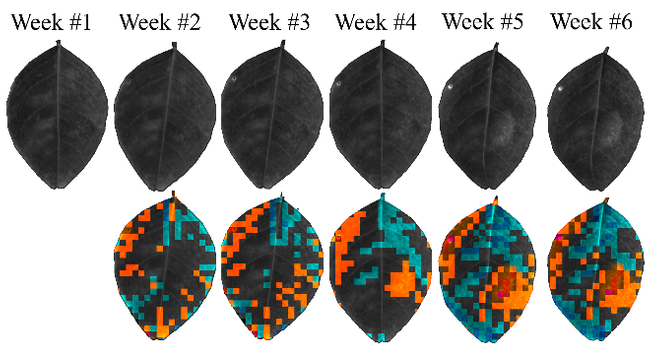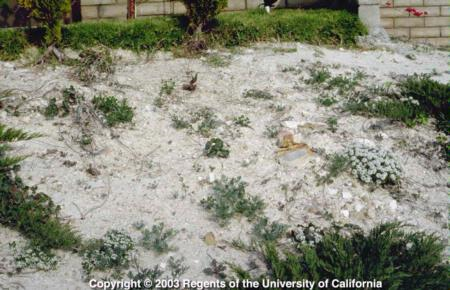
Posts Tagged: zinc
New Early Detection of Citrus HLB
Kearney Research and Extension Center, University of California Cooperative Extension
California is the major producer of fresh market citrus in the U.S., a $2 billion industry that is threatened by a devastating disease called citrus Huanglongbing (HLB). Unfortunately, there is no cure for this disease and if a tree gets infected, it will die in a few years. In Florida, HLB was first seen in 2005, but after a few years the entire state of Florida got infected. Today, about 60% of Florida citrus has gone, mostly because there was no efficient HLB monitoring practice. HLB diagnosis using laboratory-based methods required manual sampling and they were time and effort consuming. An efficient HLB management requires high spatial and temporal resolution monitoring and eradication of infected trees. Therefore, a diagnosis sensor is needed for detecting HLB infected canopies before the development of symptoms. For high resolution monitoring, the sensor should also be able to conduct rapid and inexpensive inspection with high accuracy.
Starch accumulation in HLB infected leaves is an early indication of the disease. Starch has an optical characteristic of rotating the polarization plane of light. We employed this characteristic of starch to develop an early detection methodology in which the sensing system was very sensitive to the rotation in polarization plane of light. The sensor has a customized illumination system including 10 high-power and narrow band LEDs at 591 nm and a polarizing film. The sensor also has a monochrome camera equipped with a linear polarizing filter that is set in a perpendicular direction to the polarizing film of the illumination system.
Starch accumulation in an HLB infected leaf generates blotchy mottle in an asymmetrical yellowing pattern. Deficiency of certain nutrients such as Mg and Zn causes symptoms similar to HLB.
The sensor was mounted on a gator vehicle and was tested in a citrus grove in Florida. The polarized images acquired from healthy, HLB, and Zn deficient canopies were further analyzed for diagnosis purpose.
HLB samples were accurately identified from healthy and Zn deficient samples. Also, the sensor was able to detect HLB within Zn deficient samples.
The polarized imaging methodology was adopted in two separate studies at the University of Florida to investigate the earliest time HLB can be diagnosed by polarized imaging technique after infection. In one study, two-year old Valencia orange plants were inoculated using disk-graft method.
Time-lapse polarized images of leaves from inoculated citrus plants were acquired on a weekly basis. HLB symptoms (as starch accumulation) started to become visible in the polarized images five weeks after inoculation, while the plants were still in asymptomatic stage.
In another study, the polarized imaging methodology was employed to detect HLB in insect inoculated citrus seedlings while in asymptomatic stage. Citrus seedlings were exposed to intensive HLB-positive Asian Citrus Psyllid (ACP) feeding. Polarized images were acquired two times; once after one month after inoculation and again two months after inoculation. As well as HLB detection, the level of infection was obtained for different leaf samples. Polymerase chain reaction (PCR) tests were conducted to validate the HLB status and the level of infection in each leaf sample.
Currently, we focus on improving the accuracy and early detection performance of the polarized imaging sensor and developing a commercialized product for practical in-field diagnosis. This affordable tool can help the California citrus growers to protect their groves from HLB.
Photos, from top to bottom:
Sensor Prototype
Leaf Symptoms of HLB and Zn Deficiency
Time Lapse Images of HLB Infected Leaves Over Time

Detection Sensor Prototype HLB

HLB healthy and Zn deficient

HLB leaves starch
Calcareous Soil Confusion
Calcareous soils have often more than 15% CaCO3 in the soil that may occur in various forms (powdery, nodules, crusts etc…). They are relatively widespread in the drier areas of the earth. California is notable for its young soils, that is, soils that have a relatively high level of nutrients because low rainfall means that natural productivity has not been leached out. The potential productivity of calcareous soils is high where adequate water and nutrients can be supplied. Water is the most limiting input to making California soils productive.
The high pH associated with these soils, though, is not the level of calcium present. It is the carbonate in the soil or the bicarbonate associated with the waters found in those soils which controls the pH. The high pH then controls the availability of iron, zinc, manganese and copper. These nutrients need to be added as foliars or soil applied, or better yet, the soil pH needs to be dropped to around 7 to make these nutrients available.
Recently someone asked if replacing the calcium with potassium would change the pH. No, it won't. The carbonate needs to be removed. Calling it a calcareous soil confuses people about what caused the high pH. The carbonate or bicarbonate needs to be removed with acidification, it turning it into CO2 gas. This is done with urea sulfuric acid or sulfuric or sulfurous acid. There are actually magnesium dominated soils in the San Luis Obispo area that have high pHs due to carbonates. They are carbonateceous.

calcareous soil
Zinc and Phosphorus
I was recently in an avocado orchard and saw the rounded fruit and small leaves typical of zinc deficient trees. I asked the grower if there were recent leaf analysis of the orchard, and so we looked at them. The leaves were running at 20 ppm which is low. Sufficiency runs at 50 ppm. The recommendation was to apply zinc sulfate to the soil. The recommendation included, though 200 pounds of phosphorus per acre. Phosphorus and zinc are antagonistic, meaning applying one can limit uptake of the other. In applying phosphorus at such a high rate was probably preventing uptake of zinc. It is also antagonistic to copper, iron and manganese, so all of these micronutrients can be limited by phosphorus applications.
There have only been two documented cases of phosphorus deficiency in fruit trees, walnuts on a volcanic soil in Lake County and oranges on decomposed granite in San Diego. It is an essential element, yes, but applying it when there is sufficiency in the leaves can lead to other problems which can be hard to correct. Generally speaking, phosphorus does not need to be applied to fruit trees in California. In other states that have peat soils, high carbonates or highly weathered soils, phosphorus application is a normal practice, but here make sure you need it before applying it.
When to Fertilize Avocado and Citrus in California
Citrus and avocado are of subtropical and tropical origin are cold-tender plants that have not developed the effective cold hardening process of deciduous trees that drop their leaves and go dormant. Even within deciduous, temperate tree species there are ranges of frost tolerance. Subtropicals do have the capacity to develop some cold tolerance and this is by going through quiescence, a sort of resting condition of no or slow growth when cooler temperatures arrive. Quiescence is induced several weeks after 40-50 degree F temperatures arrive. Cold tolerance develops most when trees are not flushing. The healthier and less stressed the tree, the more responsive it is to the cooler temperatures that induce quiescence. A tree that has been recently pruned or nitrogen fertilized is more likely to continue flushing through the cold-induction of early winter and is more subject to cold damage. Unfortunately along the coast, there can be warm temperatures that occur during the winter. This can break quiescence and the trees start flowering or flushing and when cold weather arrives again, the trees are now more susceptible to cold.
Because an evergreen canopy like avocado continues to transpire, the roots of subtropicals continue to operate to deliver water to the leaves. The leaves though are not doing much other than losing water. Therefore, there is not much demand nutritionally on the part of the tree. In fact, fertilizing with nitrogen can break the quiescence and make the tree more susceptible to cold. The tree already stores the bulk of its nutritional needs in the roots, branches, stems and leaves and can call on nutrients if it needs them. Supplemental fertilizer at the time of quiescence, though, can result in an excess of the tree’s needs and induce flushing. The goal is to go into winter with adequate storage, so that when spring comes, the nutrients are there for the demanding flowering period. Adequacy is based on previous fertilizer applications, tree condition, leaf analysis and crop load. Nitrogen applications applied in winter are also susceptible to high losses from leaching and volatilization, resulting in environmental problems.
So fertilizer timing starts with when the first frosts might come. Along the coast in Southern California, the last nitrogen application should be no later than October 1, in preparation for frosts than can occur in December. Nitrogen can resume March 1 in most cases. Then the next issue is how frequently to apply nitrogen after that. The more frequent/small applications that are made, the more efficiently it is taken up, so the less that is required. Continuous injection is ideal, but most operations are not equipped to do it this way. Setting a monthly time for injection, such as the first of the month, is the next most efficient. Whatever timing you use, though, nitrogen applications should be confined to the spring and summer months with some possible in early fall.
As for potassium, it is not so liable to cause flushing and is not so susceptible to leaching and has no volatilization. It can be applied most any time and will not go anywhere other than through erosion, waiting for the tree’s roots to absorb it. Microelements such as iron and zinc though, need an actively growing root system for uptake. Their soil application should be limited to the summer time.

fertilizer injection
